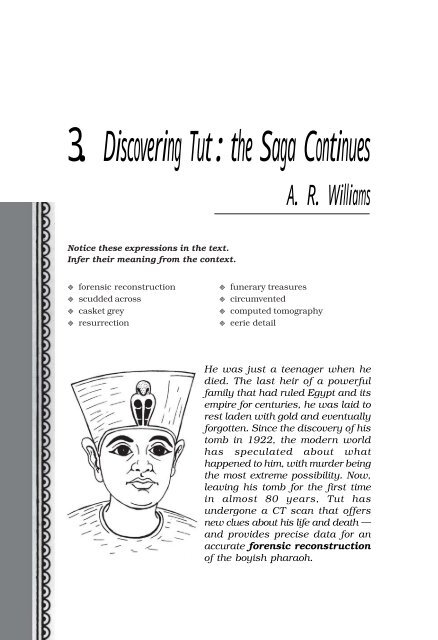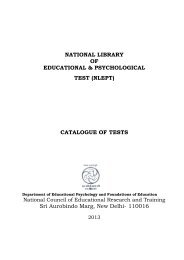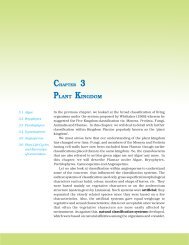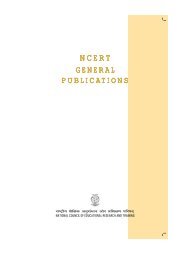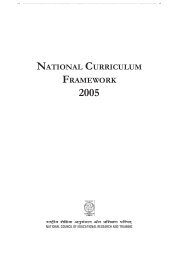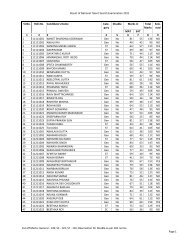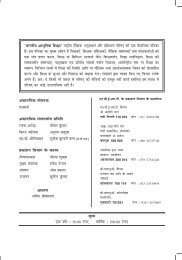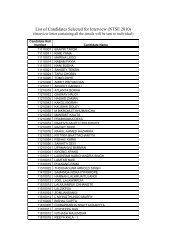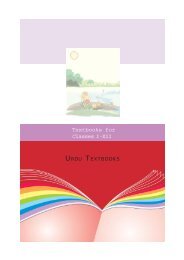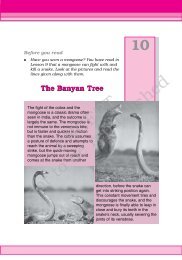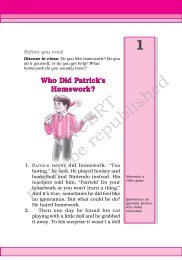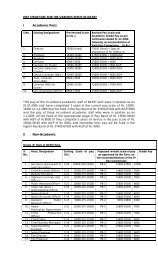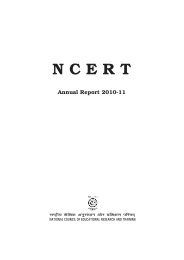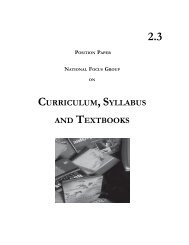Chap-03 discovering tut - National Council Of Educational Research ...
Chap-03 discovering tut - National Council Of Educational Research ...
Chap-03 discovering tut - National Council Of Educational Research ...
You also want an ePaper? Increase the reach of your titles
YUMPU automatically turns print PDFs into web optimized ePapers that Google loves.
22 HORNBILL<br />
3. Discovering Tut: the Saga Continues<br />
A. R. Williams<br />
Notice these expressions in the text.<br />
Infer their meaning from the context.<br />
forensic reconstruction<br />
scudded across<br />
casket grey<br />
resurrection<br />
funerary treasures<br />
circumvented<br />
computed tomography<br />
eerie detail<br />
He was just a teenager when he<br />
died. The last heir of a powerful<br />
family that had ruled Egypt and its<br />
empire for centuries, he was laid to<br />
rest laden with gold and eventually<br />
forgotten. Since the discovery of his<br />
tomb in 1922, the modern world<br />
has speculated about what<br />
happened to him, with murder being<br />
the most extreme possibility. Now,<br />
leaving his tomb for the first time<br />
in almost 80 years, Tut has<br />
undergone a CT scan that offers<br />
new clues about his life and death —<br />
and provides precise data for an<br />
accurate forensic reconstruction<br />
of the boyish pharaoh.
DISCOVERING TUT: THE SAGA CONTINUES 23<br />
AN angry wind stirred up ghostly dust devils as King Tut was taken<br />
from his resting place in the ancient Egyptian cemetery known as<br />
the Valley of the Kings*. Dark-bellied clouds had scudded across<br />
the desert sky all day and now were veiling the stars in casket<br />
grey. It was 6 p.m. on 5 January 2005. The world’s most famous<br />
mummy glided head first into a CT scanner brought here to probe<br />
the lingering medical mysteries of this little understood young ruler<br />
who died more than 3,300 years ago.<br />
All afternoon the usual line of tourists from around the world<br />
had descended into the cramped, rock-cut tomb some 26 feet<br />
underground to pay their respects. They gazed at the murals on the<br />
walls of the burial chamber and peered at Tut’s gilded face, the most<br />
striking feature of his mummy-shaped outer coffin lid. Some visitors<br />
read from guidebooks in a whisper. Others stood silently, perhaps<br />
pondering Tut’s untimely death in his late teens, or wondering with<br />
a shiver if the pharaoh’s curse — death or misfortune falling upon<br />
those who disturbed him — was really true.<br />
“The mummy is in very bad condition because of what Carter<br />
did in the 1920s,” said Zahi Hawass, Secretary General of Egypt’s<br />
Supreme <strong>Council</strong> of Antiquities, as he leaned over the body for a<br />
long first look. Carter—Howard Carter, that is — was the British<br />
archaeologist who in 1922 discovered Tut’s tomb after years of<br />
futile searching. Its contents, though hastily ransacked in antiquity,<br />
were surprisingly complete. They remain the richest royal collection<br />
ever found and have become part of the pharaoh’s legend. Stunning<br />
artefacts in gold, their eternal brilliance meant to guarantee<br />
resurrection, caused a sensation at the time of the discovery —<br />
and still get the most attention. But Tut was also buried with<br />
everyday things he’d want in the afterlife: board games, a bronze<br />
razor, linen undergarments, cases of food and wine.<br />
After months of carefully recording the pharaoh’s funerary<br />
treasures, Carter began investigating his three nested coffins.<br />
Opening the first, he found a shroud adorned with garlands of<br />
willow and olive leaves, wild celery, lotus petals, and cornflowers,<br />
the faded evidence of a burial in March or April. When he finally<br />
reached the mummy, though, he ran into trouble. The ritual resins<br />
had hardened, cementing Tut to the bottom of his solid gold coffin.<br />
“No amount of legitimate force could move them,” Carter wrote<br />
later. “What was to be done?”<br />
The sun can beat down like a hammer this far south in Egypt,<br />
and Carter tried to use it to loosen the resins. For several hours<br />
* See map on next page
24 HORNBILL<br />
AFRICA<br />
EGYPT<br />
ASIA<br />
River<br />
Nile<br />
(map not to scale)
DISCOVERING TUT: THE SAGA CONTINUES 25<br />
he set the mummy outside in blazing sunshine that heated it to<br />
149 degrees Fahrenheit. Nothing budged. He reported with<br />
scientific detachment that “the consolidated material had to be<br />
chiselled away from beneath the limbs and trunk before it was<br />
possible to raise the king’s remains.”<br />
In his defence, Carter really had little choice. If he hadn’t cut<br />
the mummy free, thieves most certainly would have<br />
circumvented the guards and ripped it apart to remove the gold.<br />
In Tut’s time the royals were fabulously wealthy, and they<br />
thought — or hoped — they could take their riches with them.<br />
For his journey to the great beyond, King Tut was lavished with<br />
glittering goods: precious collars, inlaid necklaces and bracelets,<br />
rings, amulets, a ceremonial apron, sandals, sheaths for his fingers<br />
and toes, and the now iconic inner coffin and mask — all of pure<br />
gold. To separate Tut from his adornments, Carter’s men removed<br />
the mummy’s head and severed nearly every major joint. Once<br />
they had finished, they reassembled the remains on a layer of<br />
sand in a wooden box with padding that concealed the damage,<br />
the bed where Tut now rests.<br />
Archaeology has changed substantially in the intervening<br />
decades, focusing less on treasure and more on the fascinating<br />
details of life and intriguing mysteries of death. It also uses more<br />
sophisticated tools, including medical technology. In 1968, more<br />
than 40 years after Carter’s discovery, an anatomy professor<br />
X-rayed the mummy and revealed a startling fact: beneath the resin<br />
that cakes his chest, his breast-bone and front ribs are missing.<br />
Today diagnostic imaging can be done with computed<br />
tomography, or CT, by which hundreds of X-rays in cross section<br />
are put together like slices of bread to create a three-dimensional<br />
virtual body. What more would a CT scan reveal of Tut than the<br />
X-ray? And could it answer two of the biggest questions still<br />
lingering about him — how did he die, and how old was he at the<br />
time of his death?<br />
King Tut’s demise was a big event, even by royal standards.<br />
He was the last of his family’s line, and his funeral was the death<br />
rattle of a dynasty. But the particulars of his passing away and its<br />
aftermath are unclear.<br />
Amenhotep III — Tut’s father or grandfather — was a powerful<br />
pharaoh who ruled for almost four decades at the height of the<br />
eighteenth dynasty’s golden age. His son Amenhotep IV succeeded<br />
him and initiated one of the strangest periods in the history of
26 HORNBILL<br />
ancient Egypt. The new pharaoh promoted the worship of the<br />
Aten, the sun disk, changed his name to Akhenaten, or ‘servant<br />
of the Aten,’ and moved the religious capital from the old city of<br />
Thebes to the new city of Akhetaten, known now as Amarna. He<br />
further shocked the country by attacking Amun, a major god,<br />
smashing his images and closing his temples. “It must have been<br />
a horrific time,” said Ray Johnson, director of the University of<br />
Chicago’s research centre in Luxor, the site of ancient Thebes.<br />
“The family that had ruled for centuries was coming to an end,<br />
and then Akhenaten went a little wacky.”<br />
After Akhenaten’s death, a mysterious ruler named<br />
Smenkhkare appeared briefly and exited with hardly a trace.<br />
And then a very young Tutankhaten took the throne — King<br />
Tut as he’s widely known today. The boy king soon changed his<br />
name to Tutankhamun, ‘living image of Amun,’ and oversaw a<br />
restoration of the old ways. He reigned for about nine years —<br />
and then died unexpectedly.<br />
Regardless of his fame and the speculations about his fate, Tut is<br />
one mummy among many in Egypt. How many? No one knows. The<br />
Egyptian Mummy Project, which began an inventory in late 20<strong>03</strong>,<br />
has recorded almost 600 so far and is still counting. The next phase:<br />
scanning the mummies with a portable CT machine donated by the<br />
<strong>National</strong> Geographic Society and Siemens, its manufacturer. King Tut<br />
is one of the first mummies to be scanned — in death, as in life, moving<br />
regally ahead of his countrymen.<br />
A CT machine scanned the mummy head to toe, creating<br />
1,700 digital X-ray images in cross section. Tut’s head, scanned<br />
in 0.62 millimetre slices to register its intricate structures, takes<br />
on eerie detail in the resulting image. With Tut’s entire body<br />
similarly recorded, a team of specialists in radiology, forensics,<br />
and anatomy began to probe the secrets that the winged goddesses<br />
of a gilded burial shrine protected for so long.<br />
The night of the scan, workmen carried Tut from the tomb in<br />
his box. Like pallbearers they climbed a ramp and a flight of<br />
stairs into the swirling sand outside, then rose on a hydraulic<br />
lift into the trailer that held the scanner. Twenty minutes later<br />
two men emerged, sprinted for an office nearby, and returned<br />
with a pair of white plastic fans. The million-dollar scanner had<br />
quit because of sand in a cooler fan. “Curse of the pharaoh,”<br />
joked a guard nervously.
DISCOVERING TUT: THE SAGA CONTINUES 27<br />
Eventually the substi<strong>tut</strong>e fans worked well enough to finish<br />
the procedure. After checking that no data had been lost, the<br />
technicians turned Tut over to the workmen, who carried him<br />
back to his tomb. Less than three hours after he was removed<br />
from his coffin, the pharaoh again rested in peace where the<br />
funerary priests had laid him so long ago.<br />
Back in the trailer a technician pulled up astonishing images<br />
of Tut on a computer screen. A grey head took shape from a<br />
scattering of pixels, and the technician spun and tilted it in every<br />
direction. Neck vertebrae appeared as clearly as in an anatomy<br />
class. Other images revealed a hand, several views of the rib cage,<br />
and a transection of the skull. But for now the pressure was off.<br />
Sitting back in his chair, Zahi Hawass smiled, visibly relieved<br />
that nothing had gone seriously wrong. “I didn’t sleep last night,<br />
not for a second,” he said. “I was so worried. But now I think I<br />
will go and sleep.”<br />
Mural in King Tut’s tomb showing King<br />
Tut with Osiris, the god of the afterlife
28 HORNBILL<br />
By the time we left the trailer, descending metal stairs to the<br />
sandy ground, the wind had stopped. The winter air lay cold and<br />
still, like death itself, in this valley of the departed. Just above the<br />
entrance to Tut’s tomb stood Orion — the constellation that the<br />
ancient Egyptians knew as the soul of Osiris, the god of the<br />
afterlife — watching over the boy king.<br />
(Source: <strong>National</strong> Geographic, Vol 207, No. 6)<br />
Understanding the text<br />
1. Give reasons for the following.<br />
(i) King Tut’s body has been subjected to repeated scrutiny.<br />
(ii) Howard Carter’s investigation was resented.<br />
(iii) Carter had to chisel away the solidified resins to raise the<br />
king’s remains.<br />
(iv) Tut’s body was buried along with gilded treasures.<br />
(v) The boy king changed his name from Tutankhaten to<br />
Tutankhamun.<br />
2. (i) List the deeds that led Ray Johnson to describe Akhenaten<br />
as “wacky”.<br />
(ii) What were the results of the CT scan?<br />
(iii) List the advances in technology that have improved forensic<br />
analysis.<br />
(iv) Explain the statement, “King Tut is one of the first mummies<br />
to be scanned — in death, as in life...”<br />
Talking about the text<br />
Discuss the following in groups of two pairs, each pair in a group<br />
taking opposite points of view.<br />
1. Scientific intervention is necessary to unearth buried mysteries.<br />
2. Advanced technology gives us conclusive evidence of past events.<br />
3. Traditions, rituals and funerary practices must be respected.<br />
4. Knowledge about the past is useful to complete our knowledge<br />
of the world we live in.
DISCOVERING TUT: THE SAGA CONTINUES 29<br />
Thinking about language<br />
1. Read the following piece of information from The Encyclopedia of<br />
Language by David Crystal.<br />
Egyptian is now extinct: its history dates from before the third<br />
millennium B.C., preserved in many hieroglyphic inscriptions<br />
and papyrus manuscripts. Around the second century A.D.,<br />
it developed into a language known as Coptic. Coptic may<br />
still have been used as late as the early nineteenth century<br />
and is still used as a religious language by Monophysite<br />
Christians in Egypt.<br />
2. What do you think are the reasons for the extinction of<br />
languages?<br />
3. Do you think it is important to preserve languages?<br />
4. In what ways do you think we could help prevent the extinction<br />
of languages and dialects?<br />
Working with words<br />
1. Given below are some interesting combinations of words. Explain<br />
why they have been used together.<br />
(i) ghostly dust devils (vi) dark-bellied clouds<br />
(ii) desert sky (vii) casket grey<br />
(iii) stunning artefacts (viii) eternal brilliance<br />
(iv) funerary treasures (ix) ritual resins<br />
(v) scientific detachment (x) virtual body<br />
2. Here are some commonly used medical terms. Find out their<br />
meanings.<br />
CT scan MRI tomography<br />
autopsy dialysis ECG<br />
post mortem angiography biopsy<br />
Things to do<br />
1. The constellation Orion is associated with the legend of Osiris,<br />
the god of the afterlife.
30 HORNBILL<br />
Find out the astronomical descriptions and legends associated<br />
with the following.<br />
(i) Ursa Major (Saptarishi mandala)<br />
(ii) Polaris (Dhruva tara)<br />
(iii) Pegasus (Winged horse)<br />
(iv) Sirius (Dog star)<br />
(v) Gemini (Mithuna)<br />
2. Some of the leaves and flowers mentioned in the passage for<br />
adorning the dead are willow, olive, celery, lotus, cornflower. Which<br />
of these are common in our country?<br />
3. Name some leaves and flowers that are used as adornments in<br />
our country.<br />
Understanding the text<br />
Factual comprehension: giving reasons, listing<br />
Talking about the text<br />
Debate on issues raised in the text related to re<strong>discovering</strong> history<br />
with the help of technology; respect for traditions (reflection on issues)<br />
Thinking about language<br />
Extinction of language and language preservation<br />
Working with words<br />
Understanding adjectival collocations; common medical terms<br />
Things to do<br />
Notes<br />
• Relating astronomical facts and legends (across the curriculum)<br />
• Finding out botanical correlates
DISCOVERING TUT: THE SAGA CONTINUES 31<br />
The Laburnum Top<br />
Ted Hughes<br />
The Laburnum top is silent, quite still<br />
In the afternoon yellow September sunlight,<br />
A few leaves yellowing, all its seeds fallen.<br />
Till the goldfinch comes, with a twitching chirrup<br />
A suddenness, a startlement, at a branch end.<br />
Then sleek as a lizard, and alert, and abrupt,<br />
She enters the thickness, and a machine starts up<br />
<strong>Of</strong> chitterings, and a tremor of wings, and trillings —<br />
The whole tree trembles and thrills.<br />
It is the engine of her family.<br />
She stokes it full, then flirts out to a branch-end<br />
Showing her barred face identity mask<br />
Then with eerie delicate whistle-chirrup whisperings<br />
She launches away, towards the infinite<br />
And the laburnum subsides to empty.<br />
laburnum: a short tree with hanging branches, yellow<br />
flowers and poisonous seeds<br />
goldfinch: a small singing bird with yellow feathers on<br />
its wings
32 HORNBILL<br />
Find out<br />
1. What laburnum is called in your language.<br />
2. Which local bird is like the goldfinch.<br />
Think it out<br />
1. What do you notice about the beginning and the ending of the<br />
poem?<br />
2. To what is the bird’s movement compared? What is the basis for<br />
the comparison?<br />
3. Why is the image of the engine evoked by the poet?<br />
4. What do you like most about the poem?<br />
5. What does the phrase “her barred face identity mask” mean?<br />
Note down<br />
1. the sound words<br />
2. the movement words<br />
3. the dominant colour in the poem.<br />
List the following<br />
1. Words which describe ‘sleek’, ‘alert’ and ‘abrupt’.<br />
2. Words with the sound ‘ch’ as in ‘chart’ and ‘tr’ as in ‘trembles’ in<br />
the poem.<br />
3. Other sounds that occur frequently in the poem.<br />
Thinking about language<br />
Look for some other poem on a bird or a tree in English or any other<br />
language.<br />
Try this out<br />
Write four lines in verse form on any tree that you see around you.
THE LABURNUM TOP 33<br />
This poem has been placed after a text which has references to<br />
names of plants for thematic sequencing.<br />
Understanding the poem<br />
• Glossing of ‘laburnum’ and ‘goldfinch’<br />
• Factual understanding<br />
• Movement of thought and structuring (poetic sensitivity)<br />
• Focus on figures of speech and imagery used (poetic sensitivity)<br />
• Attention to sounds, lexical collocations (poetic sensitivity)<br />
Thinking about language<br />
Notes<br />
• Finding equivalents in other languages (multilingualism)<br />
• Relating to thematically similar poems in other languages<br />
(multilingualism)<br />
• Attempt at creativity


